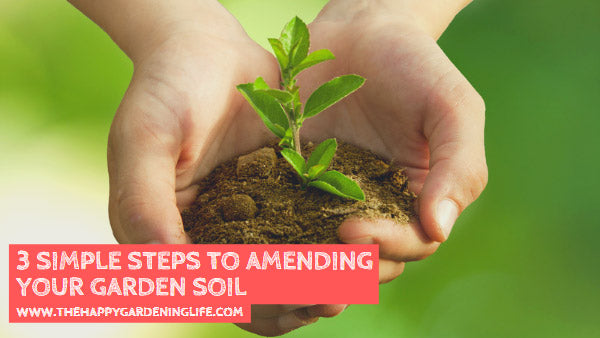
3 Simple Steps to Amending Your Garden Soil
Share
 Have you monitored your garden soil lately? If you haven't, maybe you should check it now for any potential soil problems. You’ll know if your soil is problematic when there’s an unbalance of pH levels, lack of nutrients, or too much water in it. All of these factors can cause soil destruction, and will eventually make your soil unusable for the next growing season.
Have you monitored your garden soil lately? If you haven't, maybe you should check it now for any potential soil problems. You’ll know if your soil is problematic when there’s an unbalance of pH levels, lack of nutrients, or too much water in it. All of these factors can cause soil destruction, and will eventually make your soil unusable for the next growing season.
Don’t worry though because these soil issues can be improved with a few simple tips. First of all, study your garden soil’s health. Test it using an appropriate tool to know its pH level, then make the necessary adjustments to meet your soil’s needs.
Secondly, create a proper water drainage. Remember that too much water in the soil will diminish essentials nutrients and drown your precious plants.
Lastly, make use of organic matter like compost and other natural fertilizers. This way, your garden soil will be able to receive more nutrients and consequently help your plants grow healthy and strong.
So these are some practical ways to amend your soil for your next gardening activity. For more details, please refer to these 3 simple steps listed below.
Want to tell your friends about this blog post? Click on the share buttons now!
3 Simple Steps to Amending Your Garden Soil
Step 1: Study Your Soil
To start, you must first test your soil and understand what might be wrong. A simple home pH kit is all you need to find out if your soil is acidic or alkaline. Once you know your soil’s pH, the proper adjustments can be made. The pH of your soil will limit what type of plants can be grown. Each plant has an optimal soil pH range.
Step 2: Plan for Drainage
Once you know what type of soil you’re dealing with and what type of plants you can grow, think about drainage.
If your yard or garden floods throughout the season, that’s likely your number one problem. Fortunately, drainage issues in most yards can be fixed by digging a trench and installing an in-ground drainage system. This is where you’ll need to strap on your tool belt-here’s a simple step-by-step plan to fix any yard’s drainage, but you’ll need a few tools, like a shovel, hammer and a cordless drill. The extent of this project will depend on the size of your garden and yard.
If you’re overwhelmed by flooding, remember that others have it worse, and are still able to grow a garden.
Step 3: Give Something Back to the Soil
The trench is dug and you have proper drainage; now, let’s naturally improve your soil so you can have that magical garden you’ve always dreamed of.
Brande Plotnick, with Tomato Envy, suggests vermicomposting. Plotnick describes this process as, “turning household and kitchen waste into a valuable soil conditioner that can be safely used anytime and with any type of plant.”
Other suggestions for improving your garden soil include using natural fertilizers. Award-winning landscape designer and acclaimed author Julie Moir Messervy says, “The best fertilizers are manure, fish emulsion, composted leaves, diluted urine, composted food scraps, and other organic materials that will enhance both the nutritional composition and the texture of the soil. These natural fertilizers are very effective because they improve the WHOLE soil and are less likely to create nutritional imbalances.”
And if you’re starting a new garden over one that you’ve let go for a few years, consider “lasagna gardening.” Lasagna gardening isn’t what you’re growing in your garden, but a method of gardening that requires no digging or tilling. You’re simply creating layers of organic composted material on top of already existing weeds and soil to create layers, like lasagna. Materials such as coffee grounds, peat moss and food scraps can all make up layers. This type of gardening can help improve your soil from the bottom up, says Plotnick.
Article Source: motherearthnews.com
